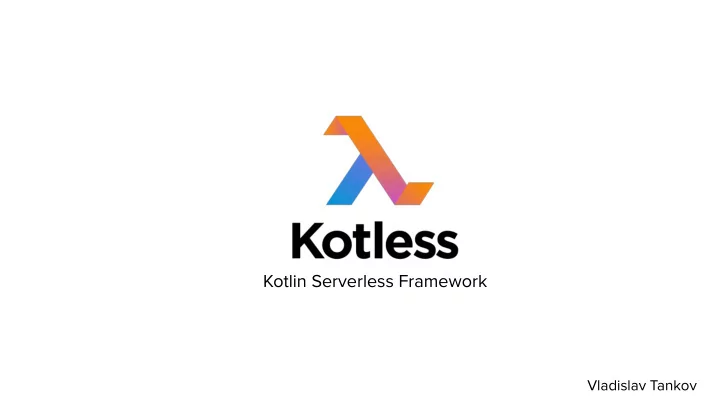

Kotlin Serverless Framework Vladislav Tankov
What is serverless?
cloud-computing execution model , in which the cloud provider runs the server and dynamically manages the allocation of machine resources Wikipedia
How are serverless applications built? ● Three simple steps: ○ Take small elements – stateless functions Compose them with events into an application ○ ○ Deploy it to Cloud runtime
Still, the idea is pretty simple
Implementation should also be simple, right?
@Get("/hello-world") fun helloWorldRoute(): String { return "Hello World" }
People deploy Serverless applications with Infrastructure as Code approach
Infrastructure as Code (IaC) is the process of managing and provisioning computer data centers through machine-readable definition files, rather than physical hardware configuration or interactive configuration tools Wikipedia
With Infrastructure as Code it is not that simple
### API route: GET /long variable "_long_envvars" { type = "map" default = { KOTLESS_PACKAGES = "kotless" } } resource "aws_lambda_function" "_long" { function_name = "Handler__long" s3_bucket = "${aws_s3_bucket.ktltst_lambda_s3.bucket}" s3_key = "${aws_s3_bucket_object.ktltst_bucket_object.key}" Tons of configuration source_code_hash = "${base64sha256(file("../build/libs/kotless-dsl-1.0-all.jar"))}" handler = "kotless.Lambda::handleRequest" runtime = "java8" timeout = 30 role = "${aws_iam_role.ktltst_lambda_role.arn}" memory_size = 256 ● 100+ lines for this function environment = { variables = "${ var ._long_envvars}" } ● 1000+ lines for a simple site } Separate language for configuration resource "aws_lambda_permission" "_long" { ● statement_id = "AllowAPIGatewayInvoke" action = "lambda:InvokeFunction" function_name = "${aws_lambda_function._long.arn}" principal = "apigateway.amazonaws.com" source_arn = "${aws_api_gateway_deployment.ktltst_example_deployment.execution_arn}/*/*" } resource "aws_api_gateway_resource" "_long" { parent_id = "${aws_api_gateway_rest_api.ktltst_example_rest_api.root_resource_id}" rest_api_id = "${aws_api_gateway_rest_api.ktltst_example_rest_api.id}" path_part = "long" } resource "aws_api_gateway_method" "_long" { rest_api_id = "${aws_api_gateway_rest_api.ktltst_example_rest_api.id}" resource_id = "${aws_api_gateway_resource._long.id}" http_method = "ANY" authorization = "NONE" } resource "aws_api_gateway_integration" "_long" { rest_api_id = "${aws_api_gateway_rest_api.ktltst_example_rest_api.id}" resource_id = "${aws_api_gateway_method._long.resource_id}" http_method = "${aws_api_gateway_method._long.http_method}" depends_on = [ "aws_api_gateway_method._long" ] integration_http_method = "POST" type = "AWS_PROXY" uri = "${aws_lambda_function._long.invoke_arn}" }
Could it be simpler?
@Get("/hello-world") fun helloWorldRoute(): String { return "Hello World" }
Infrastructure can be deduced from code
Infrastructure SHOULD be deduced from code
Infrastructure in Code ● Application framework and deployment tool: ○ Write the code with the help of the framework Introspect the code during deployment ○ ○ Create infrastructure and deploy the application ○ Weave the application into the infrastructure in runtime
That is what Kotless does
Actual Kotless code @Get("/hello-world") fun helloWorldRoute(): String { return "Hello World" }
Kotless ● Infrastructure in Code tool for Kotlin: ○ Kotless DSL for HTTP events Gradle plugin for deployment ○ ○ Uses Terraform under the hood ○ Supports AWS
Kotless-based application
How does it work?
What it gives us ● Cloud agnostic scheme ● Abstraction of deployment Abstraction of DSL ●
Why not support existing framework?
Ktor-based application
Several DSLs
Seamless serverless ● Write the code with any web framework you like ○ Ktor Run it locally ● ● Deploy it ○ As a serverless app to cloud ○ As a standalone app in-house
Let’s go even further
Scheduling? @Scheduled( every5Minutes ) fun scheduledRoute() { println ("What a lovely day!") }
Permissions? @DynamoDBTable("table", ReadWrite) object URLStorage { fun getByCode(code: String): String? { ... } }
Code may fully define ● API interaction: @Get, @Post, ... ● Events handling: @Scheduled, … Permissions requirements: @DynamoDBTable, ... ● ● Shared structures: Queue, List, ... ● Calls of functions: async { … }, ….
Kotless advanced features
What’s next?
More is coming ● We are working hard on: ○ Supporting other clouds Kotless MPP ○ ○ Extended event handling ○ Much more
Give Kotless a try! github.com/JetBrains/Kotless vladislav.tankov@jetbrains.com Remember to vote!
Serverless IS ● Very popular topic: ○ Top-growth cloud service 2nd year Almost as popular as Kotlin on StackOverflow ○ ○ 10 percent less interesting than ML (39% / 49%) ○ Even standardization is on the way ■ CloudEvents.io Knative ■
Serverless IS ● Applications building approach: ○ Decouple the app as much as possible Make use of cloud provider’s managed services ○ ○ Connect it with the outer world via provider’s API
8 Why to serverless?
Make the provider manage your infrastructure
Why to serverless ● Benefits all the way: ○ Automatic scaling Fault tolerance ○ ○ Cost ■ Is it?
Why to serverless ● Hundreds of frameworks: ○ Infrastructure as a Code Serverless.com ■ ■ CDK ■ Terraform ○ Infrastructure in a Code AWS Chalice ■ ■ Kotless ■ Osiris
Why to serverless ● Availability: ○ Courses Books ○ ○ Samples ○ Researches
13 The Great Serverless Myth
Serverless is not a thing without servers
It’s all about management ● Reducing the pain of managing: ○ Scale Price ○ ○ SLA ○ Complexity
15 Serverless is overcomplicated
Recommend
More recommend